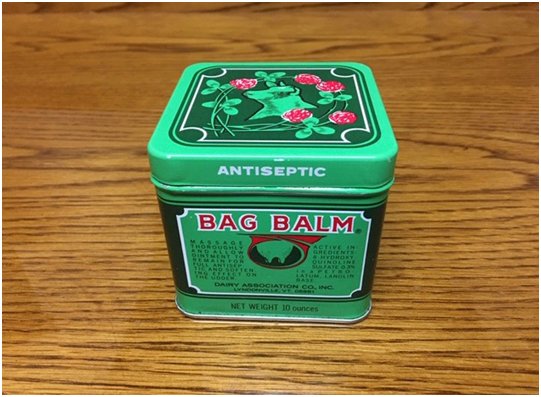Q: One of my friends uses Bag Balm® for cuts, abrasions, and dry skin on herself and her family and swears it really works. Does it contain an antibiotic?
Ten years ago, my parents downsized, and they asked me to help clean their medicine cabinet. On the top shelf, I found an ancient bottle of mercurochrome. Right next to it was a half-used tube of drawing salve, and a bottle of aspirin tablets so old that the label was almost completely faded. A battered green metal can of Bag Balm was the only thing on the shelf below. Its active ingredients included “0.005% mercury from ethylated mercury sterols, petrolatum, and lanolin.”
Mercury? REALLY? The side of my own can of Bag Balm® read, “ACTIVE INGREDIENTS: 8-hydroxyquinoline sulfate 0.3% in a petrolatum, lanolin base.”
In 1899, when John L. Norris purchased the formula that eventually became Bag Balm®, mercury compounds were commonly used as anti-infectives. I even found an old bottle of Mercurochrome® in my parents’ medicine cabinet next to the Bag Balm®. I remember my mother painting my scrapes and cuts with its bright red liquid. Both Mercurochrome® and its colorless cousin Merthiolate® were popular, topical antiseptics that contained mercury as their active ingredient.
Unfortunately, mercury compounds aren’t as potent as other anti-infectives and may cause mercury poisoning if applied to broken skin or used over a long time. In 1992 the Food and Drug Administration (FDA) issued a statement that declared topical mercury compounds for topical use as anti-infectives were neither safe nor effective. In 1998 the use of mercury compounds in topical products was banned by the FDA, resulting in the removal of the original formulas of Merthiolate® and Mercurochrome® from the shelves of pharmacies and grocery stores across America.
When did Bag Balm® change its formula from a mercury compound to its current one with 8-hydroxyquinoline? Going to the source, I called Lyndonville, Vermont, the home of the Dairy Association Company, Inc, manufacturers of Bag Balm®. I asked them, “When did you swap out the mercury in your product for 8-hydroxyquinoline? Did the FDA make you do it in 1998?”
According to Charles Allen, Vice President of the Dairy Association Company, they removed mercury from the Bag Balm® formula in 1972. But what he said next really surprised me. “The 8-hydroxyquinoline anti-infective has been part of the formula from the very beginning. All we did was change the labeling on the cans.”
Bag Balm® was initially marketed to dairy farmers to treat cow udders. It was useful in keeping the exposed skin from getting chapped and helped heal minor cuts and scrapes. Most of us recognize Bag Balm’s distinctive green square metal can that is sold in both 10-ounce and 1-ounce sizes. The Dairy Association Company, Inc continues to be family-owned. It manufactures and ships the ointment from their facility in Lyndonville, Vermont, all over the world. Although it clearly states on the can Veterinary Use Only, many folks use it on their own cuts and chapped body parts with excellent results.
I used Bag Balm® on myself several years ago to treat an inflamed cut on my ring finger. Despite soaking the gash in Epsom salts and applying non-prescription antibiotics like Neosporin® ointment, it didn’t improve. When it started to swell and become painful, I set up an appointment at the doctor for the following day. That night, as my finger turned red and warm to touch, I decided to change my strategy.
I soaked my sore finger one more time in Epsom salts. Then, I applied a liberal coating of Bag Balm® instead of the antibiotic ointment I had been using. Covering my finger with a fresh bandage, I went to bed. I didn’t expect much improvement, so the next morning, I was astounded when I removed the dressing. My cut was nearly back to a normal color, and I saw only minor pain and swelling. The 8-hydroxyquinoline in the Bag Balm® worked when Neosporin® didn’t.
8-hydroxyquinoline has an excellent reputation as a topical anti-infective. It has been used as the active ingredient in in older formulations of non-prescription liquid bandage products such as New Skin®, Nexcare®, and Skin Shield®. The 19th edition of the United States Dispensatory published in 1907 describes 8-hydroxyquinoline as a “potent antiseptic.”
8-hydroxyquinoline works to impede bacteria and fungi by binding to certain trace minerals on the surface of these organisms and transforming into a toxic compound that poisons them. Compounds closely related to 8-hydroxyquinoline are being studied as possible new weapons against “super-bugs” resistant to multiple antibiotics.


